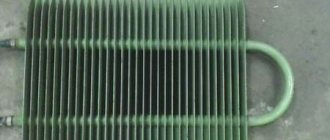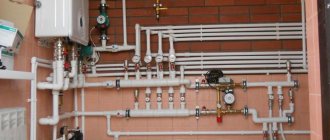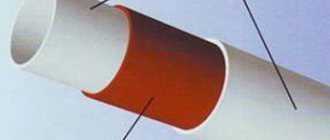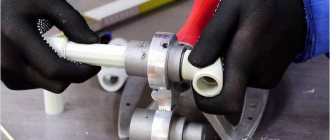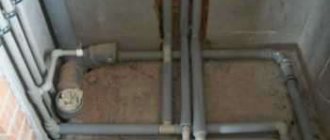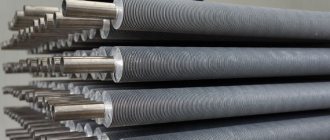general characteristics
Fiberglass-reinforced pipes create serious competition for analogs reinforced with aluminum foil. These risers are characterized by a three-layer construction: polypropylene - fiberglass - polypropylene. The reinforcing layer is also made of propylene, reinforced with fiber fibers - glass fibers. In terms of its technical parameters, the adhesion of plastic to fiberglass can be compared to the strength of a monolith.
For fiberglass-reinforced pipes, the following marking is characteristic: PPR-FB-PPR.
If we compare the risers with an aluminum and fiberglass frame, then the first option has one significant advantage: the products have greater rigidity. This means that when installing systems with a length of 1.5 meters or more, such risers must be attached to the walls with special fasteners. Otherwise, sagging, deformation, failure of the structure is possible.
Regarding diameters, it should be noted that products can be produced with a diameter of 20 mm to 110 mm. It is these risers that can be found on sale more often than others. Although, for example, elements with a diameter of 17 mm or less are used for arranging underfloor heating.
Products of small diameters are fixed with plastic clips, and large ones - with clamps.

Polypropylene products
The technical characteristics of glass fiber reinforced polypropylene pipes depend on the polymer used for their manufacture. All products are marked, which makes it possible to immediately determine the areas of use of tubular parts.
Let's find out what the markings on the pipes mean. So, PPR - English, and PPR - Russian name means that it is a Polypropylene pipe made of Random copolymer.
Such polypropylene pipes reinforced with fiberglass are used for heating, water supply, ventilation systems, industrial pipelines.
When arranging engineering networks, PPR pipes reinforced with fiberglass are increasingly used. There is nothing strange in this, since they are reliable, light enough, and there are much fewer problems with their installation.
Another important factor is cost. For example, the price of PPR pipes reinforced with fiberglass for heating is lower than metal counterparts, which helps to save the family budget. These, as well as other characteristics possessed by a polypropylene pipe reinforced with fiberglass, contributed to its popularization and application in various spheres of the national economy.
Read from this article: The main characteristics and scope of polypropylene pipes, diameter and what affects its choice. Classification by pressure and composition of raw materials. Polar questions and answers to them.
Varieties
For the implementation of various engineering projects, there are several varieties of fiberglass products. They differ in strength, durability, field of application and, as a result, final cost.
We recommend that you familiarize yourself with: Polypropylene pipes for the heating system
First of all, the type and concentration of resins added to the mixture during the production process affects the strength characteristics of the pipe. The technology allows the use of isophthalic, orthophthalic, biphenolic resins. This increases the resistance to salts, acids and alkaline compounds.
Also, the strength characteristics of the pipe are increased by increasing the number of layers:
- Single layer pipe. It is produced by winding from pure composite material. Differs in low cost and relatively low performance characteristics.
- Two-layer pipe.It has an additional outer shell that protects the product from mechanical damage, the destructive effects of ultraviolet radiation, and other corrosive environments.
- Three-layer pipe. Each layer of polymer is covered with a protective polyethylene sheath. The layers are joined together by high-temperature polymerization. The layer located in the center is the power one. Its task is to enhance the strength of the product.
When choosing fiberglass pipes for the implementation of a project, it is worth focusing on some important points:
- The pipe material must be free from inclusions of foreign elements.
- The surface should be perfectly flat and smooth, without dents or bulges.
- The edge of each product should not have delamination or cracks - this is a clear sign of rejection.
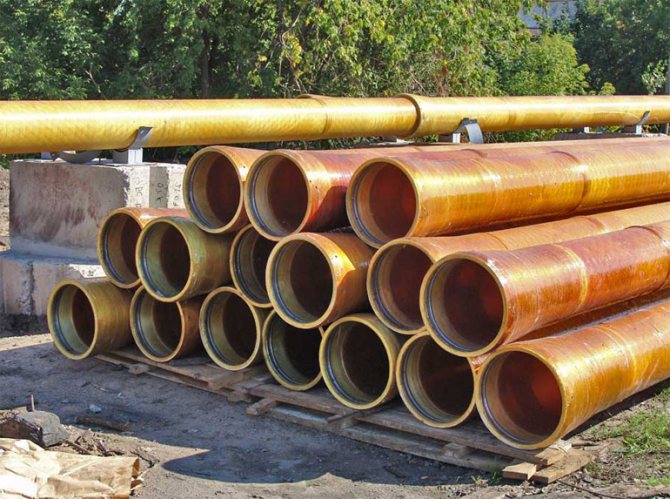

It is important! Fiberglass pipes can be cut, sharpened or drilled. A quality product does not change its performance from these mechanical influences.
What are the types of polymer pipes
At this time, 2 types of polymer products are known:
- single-layer;
- multilayer.
What are the characteristics of each type of product?
Single layer
There are 4 modifications of one-piece polypropylene risers used for heating or water supply.
1st type: PPN pipes.
Homopolypropylene is used for their production. They are used in engineering pipeline structures for cold water supply, ventilation, industrial highways.
2nd type: RRV pipes.
The production is based on polypropylene block copolymer. Products are intended for installation of underfloor heating, cold water supply networks.
3rd type: PPR pipes.
The material for the production of parts is a random polypropylene copolymer. The main property of the substance is to promote an even distribution of loads on the inner walls of pipelines.
Hot, cold water supply, floor heating systems, water radiator heating - this is the list of applications of this type of risers.
4th type: PPs pipes.
The main characteristic of the products: polypropylene with increased heat resistance is used for production.
Details of such a line are able to withstand the temperature of the transported media up to + 95⁰С. If necessary, for a short period of time, it is possible to transport the medium with a temperature of up to + 110⁰С.
The first three analogs are designed to operate at temperatures around + 70⁰С. In a short-term mode, operation is allowed at slightly higher temperature indicators.
Products of the 3rd type are covered with a special shell, which is able to completely eliminate the negative effects of ultraviolet radiation.
Important! Do not often use the system operation in the mode of maximum permissible parameters.
About multilayer analogs
Polypropylene (PP) pipes consisting of several layers are reinforced with fiberglass, used for heating, water supply. In comparison with solid structures, PP products practically do not change their linear dimensions at high temperatures of the transported media. Thanks to this property, the scope of application of solid communications is significantly expanded.
The following modifications of multilayer risers can be distinguished.
Products for the reinforcement of which perforated aluminum foil is used.
They are characterized by the presence, on the outer or middle layer, of small-diameter holes in the form of a mesh. The strength of the bond with the polymer is carried out due to the viscosity, as well as the fluidity of the substance that penetrates the holes of the aluminum layer.
Product advantages
- Low coefficient of linear expansion;
- increased strength.
Minuses
- In the process of welding, only the upper layer of the riser is joined to the fittings with sufficient reliability;
- the aluminum reinforcement must be removed before welding, since failure to do this may cause a poor-quality connection.
PP pipes with solid aluminum foil reinforcement.
The foil can be located both on the outer and on the middle layer of the pipe part, but it is imperative that polymer layers are placed on both sides of the metal.
Before starting welding, you need to cross-cut the risers. Thanks to the procedure, the possibility of aluminum contact with the moving medium is excluded.
Benefits
- Low coefficient of thermal expansion;
- increased strength properties.
The disadvantages include:
- not all interlayers are welded reliably. In places of welding, it is absolutely reliable to attach only the outer layer;
- obligatory removal of unnecessary aluminum residues, which takes a lot of time.
Important! To remove the aluminum layer before welding, you need to use a special tool. Its purpose: to accurately measure the depth to which pipes should be lowered into fittings in order to clean the inner surface at the same distance.
Failure to do so can lead to an unreliable connection, which is fraught with the occurrence of electrochemical processes when the foil comes into contact with water.
Some enterprises have mastered the production of communications of this type, the design of which does not foresee preliminary cleaning before welding.
PP products with polyethylene reinforcement.
That is, the outer layer of the pipe looks like a thick polyethylene layer.
Benefits
- Small coefficient of thermal expansion;
- no cleaning required before joining by welding;
- functioning at high temperatures.
Minuses
- When joining, a reliable connection of the fitting is possible only with the outer layer;
- full contact of the transported medium and polyethylene is not excluded;
- the strength characteristics want to be the best, since the layers are connected to each other with the help of glue.
PP pipe with fiberglass reinforcement.
Design feature: the presence of a middle polypropylene layer with a filler in the form of fiberglass. Fillers are often made colored in order to better visually distinguish them.
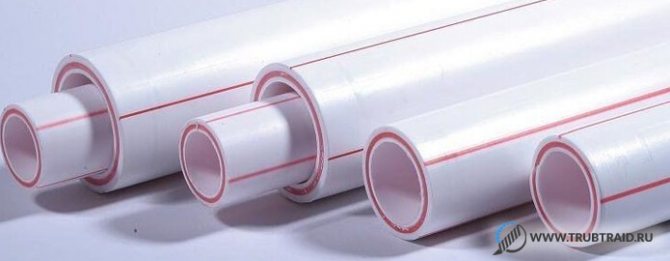

The advantages of this type of communication are greater than those of the previous analogues combined.
At first:
structures with pipes reinforced with fiberglass for heating or water supply are highly durable and solid.
Secondly:
for fiberglass-reinforced risers, a relatively low coefficient of thermal expansion is characteristic, which is about 25% less than that of unreinforced counterparts.
Thirdly:
before hot joining, there is no need to clean the ends of the elements to be joined.
Fourthly:
the fiberglass line has increased rigidity.
Fiberglass elements have one drawback, and even that has not yet been fully proven: oxygen penetration through the material.
If this fact is fully confirmed, an accelerated process of corrosion of the metal from which the boilers are made is possible.
Theoretically, such a minus is possible, but in practice, research is still being conducted.
Fiberglass pipes: past, present, future
Fiberglass Reinforced Thermosetting Plastic (FRP) is now included in many industrial products. It can be used to store and transport corrosive substances or to process certain substances in a corrosive environment. Despite the fact that the history of the production of fiberglass pipes has more than 30 years, this material is still modern and has great prospects for application in many areas of human activity.Its advantages are as follows: resistance to corrosion, an advantageous ratio of strength and weight characteristics, production and maintenance that do not require large expenditures of efforts and resources. This article will focus on the history of fiberglass pipes, their current applications and future uses in oil storage and refinery applications. Sullivan D. Curran P.E., Executive Director Fiberglass Tank and Pipe, Translation: Tsareva Anastasia https://www.aquart-info.ru Introduction
Fiberglass piping should not be confused with conventional thermoplastic piping such as PVC and polyethylene (PE). Typically the latter is based on unreinforced extruded pipe and injection-molded fittings and flanges, while fiberglass components are made from various epoxies reinforced with continuous glassy filaments. The resin used is thermosetting, i.e. after curing, it is subjected to irreversible chemical reactions, which favorably affects the ability to tolerate ultra-high temperatures. Fiber reinforcement in turn makes piping components more durable than conventional unreinforced thermoplastics, while improving performance and reducing weight. A distinction should also be made between the hand lay-up process and the production of fiberglass on special equipment. The number of manufacturers using hand layering technology is in the thousands. They target small shops that focus mainly on consumer goods such as bathroom accessories or pleasure boat parts. The number of entrepreneurs producing pipes in special installations is relatively small. These are quite large industrial companies that manufacture large batches of pipes for the oil industry, trade, industrial and municipal services, both within the country (Ed. - meaning the United States) and abroad.
Background
Before the construction of pipelines began, oil intended for transportation was pumped directly into wooden barrels. Subsequently, wood was used in the manufacture of pipelines, which was later replaced by steel. However, steel pipelines quickly corroded when exposed to salt water and high sulfur oil. But despite the fact that fiberglass was invented during World War II, the first pipe made of fiberglass and epoxy came much later, as the hand layering technology used in only a few chemical industries could not replace steel in the oil industry. since it did not provide the necessary strength and was not cost effective.
Production of pipes on special equipment
In the 1950s, centrifugal casting became the first industrial technology for the production of pipes suitable for use in the chemical industry, trade and the oil industry. Then a method was discovered for the production of pipes by the method of spiral winding of fiberglass on a rotating mandrel. In the 60s, the production of small-diameter pipes reached large volumes, the pressure of which reached 450 psi (30.62 atm). Their full-scale use began in 1964, and for the first time pipelines from such pipes were installed on pipelines for the extraction of crude oil products.
Development of norms and standards
In 1959, ASTM (American Society for Testing Materials) published nationally recognized standards and methods for testing fiberglass pipes. The first version of ASTM D1694, Standard Specification for Threads for Glass Fiber Reinforced Thermosetting Resin Pipe, was developed in collaboration with glass fiber pipe companies, petroleum and other industries. In 1968, the American Petroleum Institute (API) published the first GRP pipe standards.The first API standard was called API 15LR Specification for Glass Fiber Reinforced Thermosetting Resin Line Pipe. Numerous standards, guidelines and test procedures for fiberglass pipes are currently issued by ASTM and API.
Modern production
If earlier the use of fiberglass pipes produced on special equipment was limited mainly to the oil industry, now they are used, starting with the transportation of flammable and combustible liquids, and ending with sewer systems in the municipal economy and industrial sectors.
The following are examples of the use of fiberglass piping.
For GRP pipes used in the oil and gas industry, the maximum pressure reaches 4000 psi (272.2 atm). 4-inch (10.16 cm) pipe is used in the development of oil fields; pipes from 2 to 16 (5.08 - 40.64 cm) inches - when filtering water, both in low temperatures in Alaska and in the hot climate of the Persian Gulf. The 12-inch pipeline pumps crude oil or salt water at 290 psi (19.7 atm) and a temperature of about 120 o F (48.9 o C). Underground pipelines are used to transport flammable and combustible liquids, delivering gasoline, alcohol, and what about their mixtures to public and private gas stations within the country. Since the listing of fiberglass pipelines in the late 1960s, construction began on a large scale, with a total length of over 60 million feet. While concrete pipes are still predominantly used in sewer and drainage pipes, there are many industries where fiberglass is preferred. For example, concrete pipes used in sewer systems are quickly destroyed by hydrogen sulfide. This chemical compound eats away at the surface of the pipe, ultimately causing the walls to collapse. Fiberglass, on the other hand, is resistant to hydrogen sulfide, so fiberglass pipes were used as the inner layer of large diameter concrete pipes (48 to 60 inches - 116.84 - 152.4 cm).
Prospects for GRP pipes
Nowadays, construction and engineering firms can use computer software to create more advanced fiberglass piping systems. The software analyzes liquid and gas flows, examines pipeline spans and thrust pad designs, determines chemistry, and processes pipeline installation information. These programs facilitate various calculations, assist in the creation of new piping systems, and also allow you to identify and troubleshoot previously laid pipelines. Perhaps, in the near future, the oil and gas industry will demand larger diameter pipes that can withstand higher pressures, in connection with the need to solve the problems of corrosion prevention. In addition, it became possible to design pipes using special technologies that prevent the spread of fire. This is achieved with a special fire-resistant coating. And in the case of a liquid flowing through such a pipeline, such a system will function reliably for at least 3 hours. Fire and water repellent protection helps to reduce the weight of fiberglass pipes. This is of great importance in the creation of offshore oil platforms. Reducing the weight of the structure allows the manufacturer to reduce production costs from $ 2 to $ 4 per pound (for example, save up to 750 tons).Trenchless technologies for laying microtunnels without damaging the roadbed and other ground objects are rapidly developing.
How elements are connected to each other
Glass fiber reinforced PPR pipes can be joined into a single structure by diffusion welding or fittings (adapters, couplings, tees and other parts).
Each of the methods uses a special soldering iron, the so-called welding machine. The risers docked in this way create a monolithic non-separable structure.
The presence of special adapters in the form of threaded, flange connections makes it possible to fasten the PPR polypropylene pipe reinforced with fiberglass with a metal line corresponding to the fittings.
What is glass fiber reinforced polypropylene fiber pipe
These products are 3-layer polypropylene pipes reinforced with fiberglass FIBER.
They differ:
- increased resistance to corrosive processes and chemical influences;
- abrasion resistance;
- hygiene. Due to this property, the products have found their application in the installation of drinking water pipelines;
- environmental safety;
- long service life;
- ease of installation.
In addition, the products are versatile in their use.
This is manifested in the fact that they are used:
- when installing underfloor heating, water heating;
- for supplying hot, cold water;
- in the process of arranging drainage, sewerage systems.
Due to the design features of the risers, the product practically does not change its linear dimensions, which is very important when installing heating and ventilation communications.
Advantages and disadvantages of fiberglass pipes
The spread of fiberglass products is associated with the following advantages:
- duration of operation;
- low weight, which simplifies transportation and installation;
- low coefficient of thermal expansion;
- ease of installation;
- non-susceptibility to corrosion and inertness to aggressive media;
- wear resistance;
- strength;
- resistance to temperature fluctuations in the range from - 65º С to + 155º С;
- relatively low cost;
- environmental friendliness.
Note! There is such a disadvantage of fiberglass products as low stability with a significant load across the fibers, which leads to the formation of cracks. Therefore, to enhance the tightness, a special corrugated layer is applied from the inside.
The advantages largely outweigh the disadvantages, which, rather, can be attributed to the specifics of use.
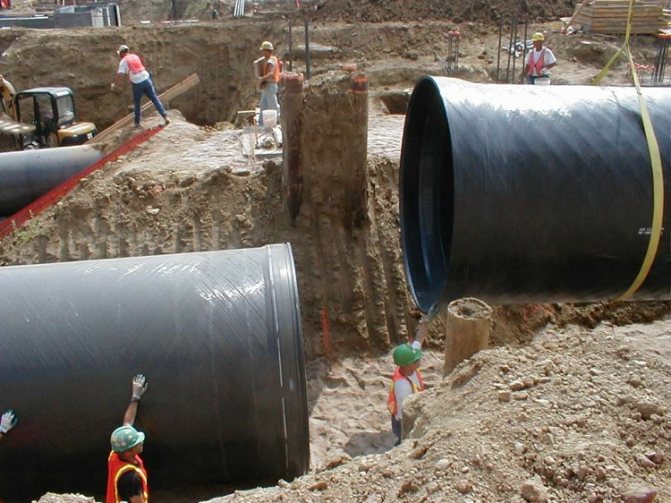

Installation of pipes can be done by the socket method, which is simple
How to choose the right one
This question is asked by everyone who deals with the arrangement of pipe structures during repairs or during the construction of a new house. The main thing is that the planned highway is of high quality and cheap.
For an optimal solution to the issue, you need to have knowledge of the technical characteristics of the system that is planned to be built.
Experts advise adhering to certain recommendations regarding other characteristics, the main ones of which are:
- diameter;
- pressure;
- manufacturers.
And then - in more detail.
Required diameters.
Today's market is saturated with products with diameters of 20-110 mm.
In everyday life, elements with a diameter of up to 40 mm are most often used. Risers of this thickness are used for arranging heating, ventilation systems, hot and cold water supply.
In some cases, the most accurate calculations are needed when installing certain communications. In such situations, it is necessary to use the services of specialists who, using formulas, will make the necessary calculations.Taking into account the maximum flow rate of water, the speed of its movement, professionals will tell as accurately as possible what diameter riser should be used in this or that case.
What pressure are the parts designed for?
To a person not familiar with the specifics of such work, the task of choosing a riser that is able to withstand a certain pressure seems rather difficult. But this is at first glance. In fact, the problem is simple to solve.
To do this, you need to: know what pressure the heating or water supply system is designed for and ... be able to read. This means that since there is a marking on all PPR pipes reinforced with fiberglass, it contains all the information about the product. It is there that it is written for what maximum pressure the product is designed.
Mostly, in everyday life, communications with the inscription PN20 are used, which means that the part can be operated in highways with a pressure of up to 20 atm. This number is exaggerated, since no such pressure is observed in household lines. For example, in heating systems of one-story buildings, the nominal pressure is 2.5 - 4 atmospheres. But a margin of safety will not hurt.
With regard to the diameter, it is necessary to select the appropriate fittings.
Important! The best option for the selection of pipes, fittings is the presence of parts not only of the same diameter, but also of the same manufacturer. When installing a structure from such elements, minimal problems are excluded.
Manufacturers
The correct choice of PPR risers also includes the choice of the manufacturer. There is no one specific company whose products would satisfy all customers.
The question is to avoid unnecessary problems. Therefore, preference should be given to that (or those) enterprise, whose reputation in the market for similar goods is impeccable.
Companies from Europe have some advantage in this regard. High quality, reliability in operation, affordable price, which means that the products of companies from Germany and the Czech Republic are popular.
In recent years, the quality of goods from Turkey and China has significantly increased.
Domestic manufacturers are a little behind them, whose products today are distinguished not only by relatively low prices, but also by proper quality. The choice is yours. The main thing is not to buy fakes. Therefore, buy goods in brand stores, while requiring a quality certificate.
In addition to these, there are other reasons that affect the choice of goods. There is, however, one thing: we did not remember at all about the service life of products made of white polypropylene. There is a reason for this. Adhering to the requirements of correct operation, the elements of the pipeline structure are fully capable of withstanding the period of time that is needed to start the next major overhaul of the building.
Such are the materials today.
